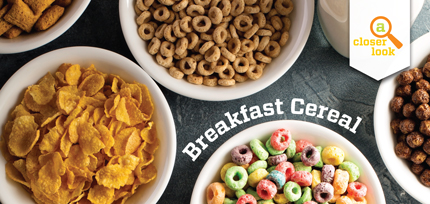WHAT IS CEREAL?
Cold breakfast cereals were invented over 100 years ago to replace the warm cereals that were typically used for breakfast until then. Cold cereals provide the convenience of ready to eat food that requires very little preparation, and are typically used with milk or a milk substitute, or as a snack.
Despite the decline in cereal consumption in recent years due to the rising trend of “on the go” foods people are still eating cereals and cereal companies have developed many different varieties and flavors. It is estimated that there are over 5,000 types of cereal available online and in supermarkets today.
HOW IS CEREAL MADE?
The production process is specific to each type of cereal. The general process is described below but it is important to note that it is slightly different for each product.
EXTRUDED CEREALS – Extrusion is a process of pushing mixed ingredients out through die (small opening in the desired shape). Grain flour is mixed with water and other ingredients, then cooked and extruded (a filling such as chocolate can be extruded into the cereal). The product is then dried in the oven.
FLAKES – The grain is cooked, dried and then flaked between two flaking rolls. Flakes can also be made by cooking grain flour and extruding it into a pellet, and then flaking it between the flaking rolls.
SHREDDED CEREAL – Cooked grains are shredded into the desired shape and then dried in the oven.
PUFFED GRAINS – Whole grain or extruded pellets are left in a pressurized & steamed vessel. The pressure is suddenly released, causing the steam to flash off and the grain to puff. The grains are then dried. All cereals can be coated with sweeteners and vitamins and then dried again.
At the end of the process the cereal can be packed as is or mixed with other
types of cereals and/or additives such as dried fruits.
IS CEREAL KOSHER?
The long ingredient lists found on cereals boxes are full of kashrus sensitive
ingredients. In addition, the equipment can pose a kashrus concern as well – as mentioned above cereal manufacturing often does not have fixed lines, and equipment can be used for different types of products. Any dairy or non-kosher ingredient can compromise the kashrus status of the products produced on the same equipment.
The vitamins that are sprayed on the cereal to add to the nutritional value are produced synthetically and need to be kosher certified. Sefardim should
not use kitniyos based cereals during Pesach without a reliable kitniyos kosher certification even if they know that the equipment is dedicated to kitniyos based cereals because the vitamins have chometz concerns.
Non-kosher ingredient inclusions such as marshmallows that are added at
the final blending do not pose a kashrus concern to the kashrus status of the equipment because the process is cold and the equipment is thoroughly cleaned afterwards.
ARE CEREALS CONSIDERED PAS OR TAVSHIL?
Only products made from the five grains (wheat, barley, oat, spelt and rye) could potentially be considered pas. This rules out any cereals made from other grains such as corn and rice. Even with the cereals made from the five grains, they are not considered pas because they do not have tzuras hapas – they are not shaped like bread.
Any product which is not considered pas is considered a tavshil and subject to the Bishul Yisroel requirements. However, breakfast cereals are not served at official meals, so the final product is not considered oleh al shulchan melachim (fit for a king’s table) and is not subject to the Bishul Yisroel requirements. In addition, cereals are not considered important by
themselves without the milk.
WHAT IS THE BROCHA?
• When any of the five grains are ground into flour and processed or crushed and cooked, the brocha is mezonos. If the whole grain is roasted or baked and still visible, the correct brocha is ha’adamah.
• Flakes made from actual grains such as corn are considered ha’adamah, but if the flakes are made from corn flour the brocha is shehakol.
• The brocha on Crispy Rice and cereals made from rice flour is shehakol for
those who follow Shulchan Oruch HaRav (but it is best to eat them as part of a hamotzi meal1) and mezonos for those who follow the Mishnah Berurah.
• When the five grains are mixed with other ingredients to make a product,
the brocha is usually mezonos, even if the amount used does not constitute
the majority of the product. However, this only applies if the flour is used to
add flavor. If it is only used as a binder to improve the consistency and texture of the product, the brocha will not be mezonos. When the ingredient from the five grains is not listed first on the ingredient list and the consumer is not sure, he should consult with his personal Rav or the kosher certifying agency.
1 Alternatively, one can first say mezonos and shehakol on
two different foods.
Rabbi Hendel is a member of the OK Kosher Vaad HaKashrus.


 EN
EN  ZH
ZH  KR
KR  BR
BR  ES
ES  IN
IN  IL
IL 




